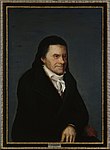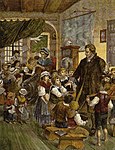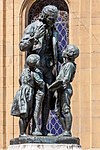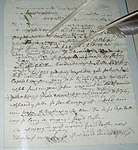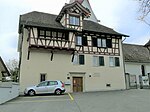Johann Heinrich Pestalozzi


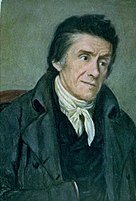
Johann Heinrich Pestalozzi (born January 12, 1746 in Zurich ; † February 17, 1827 in Brugg , Canton Aargau) was a Swiss educator . He also made a name for himself as a philanthropist , school and social reformer , philosopher and politician .
Life
Johann Heinrich Pestalozzi's parents were the surgeon Johann Baptist Pestalozzi (1718–1751) and the surgeon's daughter Susanna Hotz (1720–1796) from Wädenswil . His grandfather Andreas Pestalozzi (1692–1769), who conveyed his love for youth and the people from an early age, was a Reformed pastor in Höngg . The German-Swiss Johann Heinrich Pestalozzi attended elementary and Latin schools from 1751 to 1765 and studied first theology , then law at the Collegium Carolinum in Zurich, where he was influenced by the enlightened Johann Jakob Bodmer (1698–1783).
Despite his passionate theoretical interest in people, society and the state, he primarily wanted to be practical. So he broke off his studies in Zurich prematurely and began an agricultural apprenticeship (1767/1768) with Johann Rudolf Tschiffeli in Kirchberg ( Canton Bern ). From 1769 he tried his hand at farming in Birr in Aargau . By introducing new crops and new fertilization methods, he wanted to give the partially impoverished peasantry an example of how they could improve their situation. However, this venture failed.
In September 1769 Pestalozzi married in Gebenstorf Anna Schulthess against the will of their parents. In 1770 their son Hans Jakob (called Jakobli) was born, whom he named after Jean-Jacques Rousseau in the sense of enlightenment pedagogy , whose advice on natural child-rearing from Rousseau's writing Emile he applied point by point to his son. This attempt at an ideal child-rearing failed tragically. The diary that Pestalozzi left behind about his son's upbringing is considered a harrowing document of a serious misinterpretation of Rousseau's hypothetical pedagogy. Jakob had to learn numbers and letters at the age of three and a half. His father could be very strict; if the boy refused to study he was punished. The upbringing, the insecure external living conditions and growing up among neglected children led to Jakobli's life being accompanied by stress, fluctuations, insecurity and constant inadequacies.
At the age of eleven, Jakobli, who still could not write and read properly, was brought to live with friends in Basel. A little later he had epileptic fits . After returning to Gut Neuhof , he married Anna Magdalena Fröhlich from Brugg , a godchild of his mother Anna. They had a son, Gottlieb, in 1798. Hans-Jakob's seizures got worse and more frequent. Pestalozzi's son died on August 15, 1801 at the age of 31. Anna Magdalena Fröhlich married Laurenz Jakob Custer (1765–1822) for the second time. Her grandson is the grapevine grower and winemaker Hermann Jaeger who emigrated to America .
From around 1773/74 the Pestalozzi couple took in around 40 children on their estate. There they learned to spin, weave and “small-scale farming” in the sense of “living room education”. Pestalozzi, in his "Educational Institution for Poor Children", which was named as such from 1775, combined practical work with school lessons and moral-religious education in the "path of nature" and hoped that he could finance the project by selling textile products. This failed, however, the family got more and more into debt and had to close the institution in 1779.
From 1780 and in the following almost 20 years, Pestalozzi devoted himself primarily to writing. He became famous across Europe through his novel Lienhard und Gertrud (4 volumes, 1781–1787). Other works from this period are The Evening Hour of a Hermit (1780), Christoph and Else (1782), Legislation and Child Murder (1783), Yes or No? (1793), My research on the course of nature in the development of the human race (1797), Fables (1797).
In 1783 the Enlightenment was co-founder of the Zurich branch of the Illuminati Order (his name was Alfred ) and in 1784 he was a co-founder of the "Society for the reception of the good" in Zurich, which was a cover organization of the order. However, he lost interest in this connection in a relatively short time.
Pestalozzi, Gleimhaus Halberstadt
Pestalozzi, painted by Albert Anker
Pestalozzi monument by Hugo Siegwart in Zurich
Pestalozzi memorial stone Berlin-Lichterfelde
In 1792 the French National Assembly declared him an honorary French citizen as the only Swiss citizen . In the turmoil of the Helvetic Revolution ( French troops marched in 1798), Pestalozzi made himself available to the new Helvetic government, on the one hand through journalism (editor at the Helvetisches Volksblatt ) and on the other hand by running an orphanage and poor house in Stans (1799), where he was able to gain basic educational experience. In the following year he founded his famous educational institute in Burgdorf Castle ( Burgdorf BE ), where he developed and theoretically founded his own teaching and education method (main work: How Gertrud teaches her children ).
In 1804 Pestalozzi moved his institute to Yverdon-les-Bains ( canton of Vaud ), where he - together with a number of important employees - further developed his method and published it in numerous writings (for example To the innocence, the seriousness and the nobility of my age and my fatherland , 1815, and Schwanengesang , 1825) published. In essence, his 'idea of elementary education' demanded a natural upbringing and education that unfolds the powers and dispositions of the head (intellectual powers), the heart (moral-religious powers) and the hand (craft powers) in harmony. The Bavarian Academy of Sciences accepted him as a foreign member in 1808.
Internal disputes among the teaching staff about his successor, which had already induced Friedrich Fröbel to leave the institute in 1810, led the institute in Yverdon to ruin. In 1825 Pestalozzi also had to close this institution and withdrew to the Neuhof. In February 1827 he was brought to Brugg because of a serious illness , which should facilitate medical care. Two days later he died there in the morning hours at the age of 81. He was buried at the old school house in Birr by the local priest and the school teachers because friends and relatives were unable to arrive in time due to high snowfall or had not even heard of Pestalozzi's death. According to his wishes, a white rose bush was planted on his grave. On the occasion of his 100th birthday, the canton of Aargau built a memorial for him on the facade of the new school building in 1846.
The words are written on the tombstone
«Heinrich Pestalozzi, b. in Zurich on January 12, 1746, died in Brugg on Hornung 17, 1827. Savior of the poor at Neuhof. Preacher of the people in Lienhard and Gertrud. Zu Stan's father of the orphans, Zu Burgdorf and Münchenbuchsee founder of the new primary school. To Iferten educator of mankind. Man, Christian, citizen, everything for others, nothing for himself. Bless his name! "
Pestalozzi, for example, was highly valued by Johann Gottfried Herder and many of their ideas are identical. Swiss contemporaries also shared Pestalozzi's ideas and approaches and became active in his educational role, including Jean Baptiste Girard and Marie-Anne Calame . Joseph Anton Sickinger , a later German school reformer, adopted many ideas in his Mannheim school system , which became the starting point for further reforms in Germany and internationally in the 20th century. Pestalozzi also devoted himself intensively to teacher training. Numerous pedagogues and educators of his time got impulses from him for a more humane treatment of socially disadvantaged people and methodical and didactic tips for successful and “loving” lessons. For example , the pedagogue Johannes Ramsauer from Herisau was his assistant for 43 years and in 1838 also wrote a textbook for (single) mothers. Ramsauer later spread Pestalozzi's pedagogical ideas in Oldenburg , where he taught drawing, mathematics and natural history as the main teacher of the Cäcilien School in 1839 under the care of the Dukes of Oldenburg according to the methodological principles of Pestalozzi. Some other students of the Pestalozzian teacher training carried his life's work out into the world with complementary views:
- Georg Franz Hofmann (1765 – approx. 1838)
- Andreas Moser (1766–1806)
- Johann Caspar Zellweger (1768–1855)
- Johann Georg Tobler (1769–1843)
- Franz Voitel (1773-1839)
- Marc-Antoine Jullien de Paris (1775-1848)
- Hermann Krüsi (1775–1844)
- Johannes Niederer (1779–1843)
- Friedrich Wilhelm August Froebel (1782-1852)
- Johann Andreas Schmeller (1785-1852)
- Joseph Schmid (1785-1851)
- Johann Konrad Zuberbühler (1787-1858)
- Johannes Schneider (1792-1858)
Ludwig Wilhelm Seyffarth has dealt with Pestalozzi's work like perhaps no one else .
His contribution to pedagogy
Pestalozzi is considered a forerunner of visual education and the reform education that emerged from it at the end of the 19th century . His educational goal was holistic popular education to strengthen people for independent and cooperative work in a democratic community. Parents should be empowered to start this education at home and to be appropriate role models for their children:
«It is undisputed that such an initiation of popular education would have the effect of strengthening the strengths of domestic life for moral, intellectual and artistic education of the people and of making the fathers and mothers of the country more capable of giving their children advice from morning to evening and act to really stand by and have a truly educational influence on them in what they do. [...] It would enliven the people's power to use their abilities in the circle of their own and to be able to help themselves in all their needs independently and in the circle of their own, and increase it a million times over. "
Pestalozzi paid special attention to the elementary education of children, which should begin in the family before school. It was important to him to promote the intellectual, moral-religious and manual skills of the children on all sides and harmoniously. Today one would say that Pestalozzi took a holistic approach . His educational ideas, which he systematically presented for the first time in 1801 in his book How Gertrud teaches her children, were already beginning to be implemented in his early asylum for the poor at Gut Neuhof 1774-1780, which he had run since 1769 and located near Birr in the canton of Aargau (where he tried to imitate the near-natural way of life of the mountain farmers in the Alpine country), more specifically in the orphanage in Stans (1799) and systematically in his institutes in Burgdorf (1800-1804), where Johann Rudolf Fischer laid the foundations, and Yverdon / Iferten (1804 -1825). The content of his numerous political and educational writings is still relevant. Many of his basic ideas can be found in modern pedagogy and social pedagogy. Pestalozzi, on the other hand, deliberately did not allow grades and certificates.
The principle of Pestalozzi's pedagogy is to lay a solid foundation of elementary education that enables people to help themselves (similar to the motto “Help me to do it myself” in later Montessori pedagogy ). When imparting knowledge and skills, Pestalozzi's pedagogy strives to develop forces that are naturally inherent in the students. The inevitable development of these forces is thereby directed in an orderly way, instead of leaving it to chance. Pedagogy mediates between nature and culture, more precisely between the natural development of the child and the external rules of human coexistence and must be well informed about both aspects.
In relation to developments in infancy and toddlerhood, this approach is now supported by knowledge of the existence of time windows for neuronal maturation , for example for learning to walk and run in the first and second or language acquisition in the first to third year of life. From this it follows that elements of Pestalozzi's pedagogy can already be implemented by the parents in early childhood, for which Pestalozzi developed specially supporting learning materials.
To support the natural development of children, Pestalozzi takes into account the three-way division into “head, heart and hand”, each of which stands for intellect , customs and practical skills. In the area of the intellect, his pedagogy develops abstract judgment from the elementary activities of language, singing, writing, drawing and arithmetic. In morality, elementary feelings of love and trust form the basis for higher skills such as patience and obedience up to the highest level of religious worship and moral judgment. In physical skills, simple movements lead to more elaborate actions; Pestalozzi's contributions are less elaborated in this area. The elementary method used here also had an aftereffect, which should always progress from simple, elementary units gained in perception to more complex concepts and activities. Only through radical reduction in complexity is childlike understanding possible. The didactic reduction goes back to this.
In Heinz-Elmar Tenorth's reception in the history of upbringing and education, Pestalozzi is, among other things, a "symbol of educational pedagogy". Furthermore, thanks to his commitment to the orphanage in Stans, Ulrich Herrmann regards him as the “founder of modern social education”. He provided impulses for the professionalization and institutionalization of the education system, which were taken up both by his students and by other classics of pedagogy.
Pestalozzi's literary estate comprises 45 volumes in the “Critical Edition”. He took up Rousseau's ideas, developed them further, but partly distanced himself from them, also due to his own educational experiences.
- His contribution to sports education
Pestalozzi's elementary gymnastics (1807) had a considerable influence on the development of physical exercises in Spain and France , especially through the reception of Francisco Amorós , in Scandinavia through Pehr Henrik Ling , who copied his exercises almost verbatim. In the spirit of the pedagogues of the French Revolution, there was also moral and intellectual education as well as physical education. However, it was then used primarily in a military sense, because absolute obedience was required to carry out the exercises in unison. Gymnastics according to Friedrich Ludwig Jahn in Germany differed from this because the optimally prepared lone fighter was favored here.
Appreciation

- In 1792 Pestalozzi became an honorary French citizen.
Institutions and honors were named after the pedagogue Johann Heinrich Pestalozzi:
- Pestalozzi Prize from the University of Hiroshima
Different school buildings:
The children's villages:
- Pestalozzi Children's and Youth Village in Wahlwies, Germany
- Pestalozzi Children's Village in Trogen AR, Switzerland
and further among others
- Zurich Pestalozzi Foundation in Knonau , Switzerland
- Pestalozzi Foundation and the Pestalozzi Seminar in Burgwedel, Germany
- Pestalozzi Foundation Hamburg , Germany
- Pestalozzi calendar , a school calendar published annually since 1908, published by Pro Juventute
- the Pestalozzi Medal for loyal service to the GDR
- Pestalozzi Froebel House in Berlin, Germany
- Pestalozzi asteroid
- Pestalozzi Library Zurich and its supporting association Pestalozzi Society in Zurich , Switzerland
- Pestalozzi-Hof in Vienna
- Pestalozzigasse in the 1st district of Vienna and in Graz
- Pestalozziplatz in the Berlin district of Steglitz-Zehlendorf
- Pestalozzistraßen u. a. in Cuxhaven, Linz , Reutlingen, Magdeburg, Munich, Timișoara (Romania)
Also the Pestalozzia Zoll plant genus . & Moritzi from the pumpkin family (Cucurbitaceae) is named after him.
Works
- Pestalozzi. Complete Works. Critical edition . Founded by Artur Buchenau, Eduard Spranger , Hans Stettbacher. de Gruyter, Berlin and Zurich 1927–1996. The chief editor from 1923 to 1938 was Walter Feilchenfeld-Fales .
- Pestalozzi. All letters . Published by the Pestalozzianum u. of the Zurich Central Library, edited by Emanuel Dejung, Hans Stettbacher. Zeller, Zurich 1946–1971.
- All letters to Johann Heinrich Pestalozzi. Critical edition . 6 volumes edited by Rebekka Horlacher & Daniel Tröhler , NZZ Libro 2009–2015.
Grandfather Andreas Pestalozzi († 1769) lived in the parsonage in Zurich- Höngg , and from an early age he conveyed his love for youth and the people
literature
- Heinrich Morf : On Pestalozzi's biography. A contribution to the history of popular education , 4 volumes, Bleuler-Hausheer, Winterthur 1868–1889.
- Karl Justus Blochmann : Heinrich Pestalozzi: Traits from the picture of his life and work after self-testimonies, views and communications . Gressler, Langensalza 1897.
- Anne Fischer-Buck : Education in keeping with nature. A comparison of the teachings of Pestalozzi and Montessori applied to today's psychological pedagogy. Bouvier, Bonn 1957, 1959 (Diss. Phil.).
- Peter Stadler : Pestalozzi - historical biography . 2 volumes. Verlag NZZ, Zurich 1988 (volume 1) and 1993 (volume 2).
- Volker Kraft: Pestalozzi or the educational self . Klinkhardt, Bad Heilbrunn 1996, ISBN 3-7815-0827-7 .
- Fritz Osterwalder: Pestalozzi - an educational cult. Pestalozzi's history of impact in the development of modern pedagogy . Beltz & Gelberg, Weinheim 1996.
- Wolfgang Klafki : Pestalozzi's “Stans Letter”. An interpretation . In: Pestalozzi, Johann Heinrich: Pestalozzi on his institution in Stans. With an interpretation and a new introduction by Wolfgang Klafki. Beltz, Weinheim 1997, pp. 39-71.
- Gerhard Kuhlemann, Arthur Brühlmeier: Johann Heinrich Pestalozzi , Volume 2 in the series Basic Knowledge Pedagogy, Historical Pedagogy , edited by Christina Lost, Christian Ritzi. Schneider-Verlag Hohengehren GmbH, Baltmannsweiler 2002, ISBN 3-89676-536-1 .
- Friedemann Lüpke: Educational provinces for neglected children and young people. A systematic comparative study on problem structures of the open beginning of education. The examples of Stans, Junior Republic and Gorky Colony . Ergon-Verlag, Würzburg 2004, ISBN 3-89913-350-1 .
- Meike Wulfmeyer: Development of humanity. Johann Heinrich Pestalozzis (1746–1827) Influences on the subject teaching . In: Astrid Kaiser, Detlef Pech (Hrsg.): History and historical conceptions of general teaching . Basic knowledge of subject teaching Volume 1. Schneider, Baltmannsweiler 2004, pp. 65–68.
- Peter Ramsauer: The hike through life of the pedagogue Johannes Ramsauer in the Pestalozzis spell . Isensee, Oldenburg 2005, ISBN 3-89995-210-3 .
- Helene Ramsauer: Johannes Ramsauer et Pestalozzi. Center de documentation et de recherche Pestalozzi, Yverdon-les-Bains 2008.
- Raphael Baer: Pestalozzi on the main role of the mother in family upbringing (in it: Pestalozzi's view of Christianity as a "pure popular philosophy" ). In: Ehe, Familie, Gesellschaft , Verlag Bär, Niederuzwil 2011, ISBN 978-3-9523212-6-3 , pp. 147–166.
- Mary Lavater-Sloman : Heinrich Pestalozzi. The story of his life . Römerhof Verlag, Zurich 2013, ISBN 978-3-905894-22-6 .
- Dagmar Schifferli: Anna Pestalozzi-Schulthess. Your life with Heinrich Pestalozzi. Römerhof Verlag, Zurich 2013, ISBN 978-3-905894-23-3 .
- Daniel Tröhler: Republicanism and Education: Pestalozzi in a Historical Context. Klinkhardt, Bad Heilbrunn 2006.
- Bijan Amini: Johann Heinrich Pestalozzi. Introduction to life and work. Heseberg Verlag, Pinneberg 2018, ISBN 978-3-9819597-3-4 .
- Biographical articles in reference books
- Otto Hunziker : Pestalozzi, Johann Heinrich . In: Allgemeine Deutsche Biographie (ADB). Volume 25, Duncker & Humblot, Leipzig 1887, pp. 432-461.
- Karl Dienst : Pestalozzi, Johann Heinrich. In: Biographisch-Bibliographisches Kirchenlexikon (BBKL). Volume 7, Bautz, Herzberg 1994, ISBN 3-88309-048-4 , Sp. 250-253.
- Max Liedtke: Pestalozzi, Johann Heinrich. In: New German Biography (NDB). Volume 20, Duncker & Humblot, Berlin 2001, ISBN 3-428-00201-6 , pp. 214-216 ( digitized version ).
- Dietrich Seybold: Johann Heinrich Pestalozzi . In: Andreas Kotte (Ed.): Theater Lexikon der Schweiz . Volume 2, Chronos, Zurich 2005, ISBN 3-0340-0715-9 , p. 1395 f.
- Peter Stadler: Johann Heinrich Pestalozzi. In: Historical Lexicon of Switzerland . 20th October 2014 .
Web links
- Literature by and about Johann Heinrich Pestalozzi in the catalog of the German National Library
- Works by and about Johann Heinrich Pestalozzi in the German Digital Library
- Works by and about Johann Heinrich Pestalozzi in the catalog of the library for research on the history of education
- Publications by and about Johann Heinrich Pestalozzi in the Helveticat catalog of the Swiss National Library
- Works by Johann Heinrich Pestalozzi in the Gutenberg-DE project
- Pestalozzi in the Internet Archive
- Roger Vaissière: Pestalozzi as an educator and educational politician
- “Pestalozzi Association on the Internet”: Comprehensive Internet documentation on Pestalozzi
- Drawings by Hans Bendel for Pestalozzi's book Lienhard und Gertrud
- Arthur Brühlmeier: Working on Pestalozzi
- Arthur Brühlmeier: Pestalozzi Biography , Pestalozzi Association on the Internet
Individual evidence
- ^ Gundolf Keil : Vegetarian. In: Medical historical messages. Journal for the history of science and specialist prose research. Volume 34, 2015 (2016), pp. 29–68, here: p. 51, note 204.
- ^ Alfred Heubaum: Pestalozzi. The educator. 3. Edition. In: The great educators. Your personality and your systems. Ed. Rudolf Lehmann , Vol. 3. Felix Meiner, Leipzig 1929, p. 345.
- ↑ Information on Friedrich Fröbel at www.froebelweb.de
- ↑ Lienhard and Gertrud. A book for the people . Fourth volume 1820 (edition 1869): Chapter 76. Page 260/261.
- ↑ Gundolf Keil: Vegetarian. 2015 (2016), p. 56.
- ↑ Brühlmeier / Kuhlemann: Yverdon 1804–1825 ( Memento from April 2, 2015 in the Internet Archive ), heinrich-pestalozzi.info (accessed on March 1, 2015)
- ^ Heinz-Elmar Tenorth : History of education. Introduction to the basics of their modern development . Juventa, 4th expanded edition, Weinheim 2008, p. 94.
- ^ Christian Niemeyer: Classics of social pedagogy. Introduction to the theoretical history of a science . Juventa, 2nd revised and expanded edition, Weinheim 2005, p. 20.
- ^ PC McIntosh: Landmarks in the History of Physical Education. London: Routledge & Kegan 1981. ISBN 0-7100-0796-5
- ^ Arnd Krüger : Sport and Politics, From the gymnastics father Jahn to the state amateur. Hanover: Torch bearer 1975. ISBN 3-7716-2087-2 .
- ↑ Hiroshima University: Pestalozzi
- ^ Pestalozzi Foundation Knonau
- ↑ http://www.hobost.de/Forschung/Kader/zopestalozzi.asp (link not available)
- ↑ Lotte Burkhardt: Directory of eponymous plant names - Extended Edition. Part I and II. Botanic Garden and Botanical Museum Berlin , Freie Universität Berlin , Berlin 2018, ISBN 978-3-946292-26-5 doi: 10.3372 / epolist2018 .
| personal data | |
|---|---|
| SURNAME | Pestalozzi, Johann Heinrich |
| BRIEF DESCRIPTION | Swiss educator |
| DATE OF BIRTH | January 12, 1746 |
| PLACE OF BIRTH | Zurich |
| DATE OF DEATH | February 17, 1827 |
| Place of death | Brugg , Canton of Aargau |

